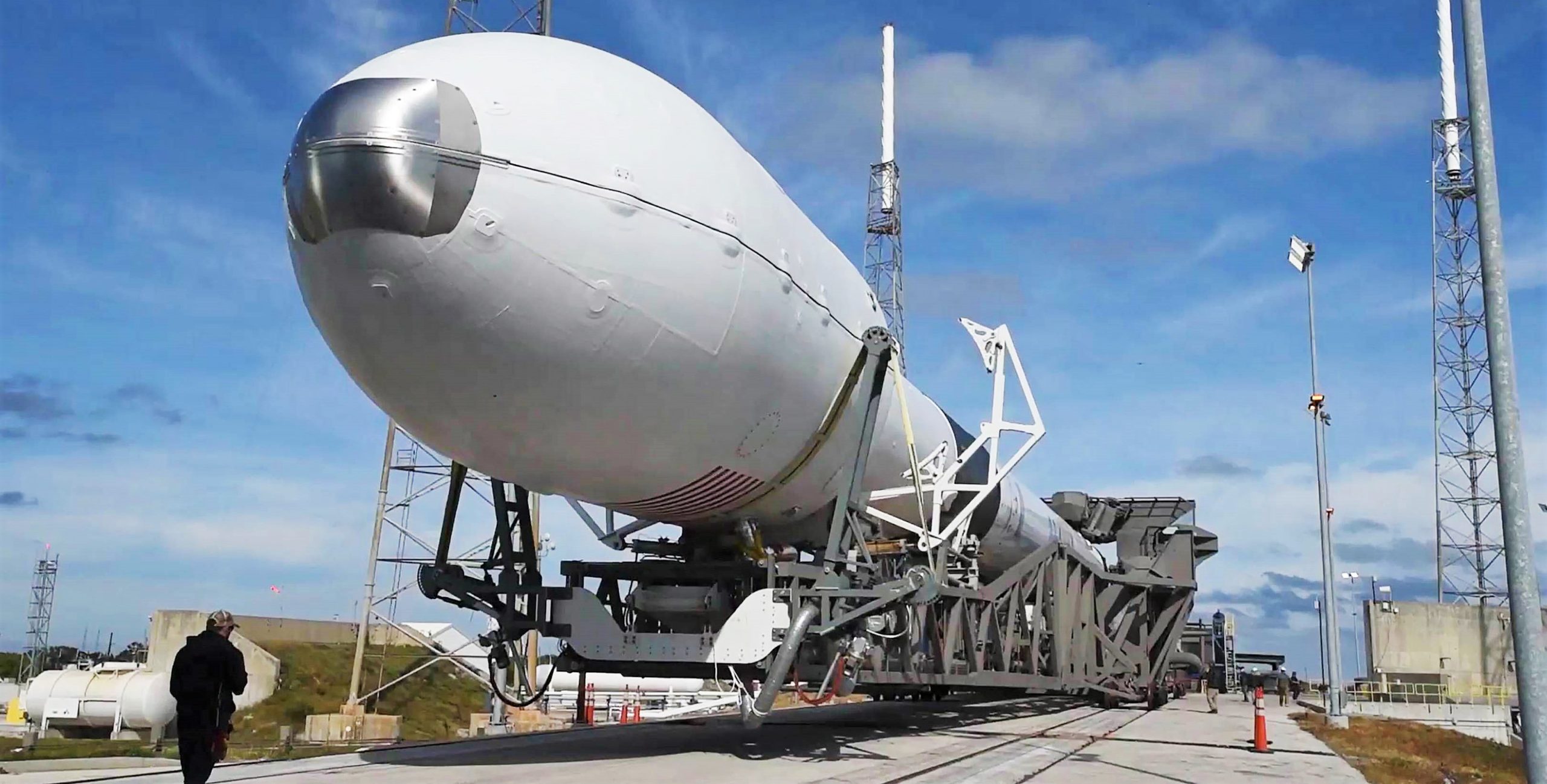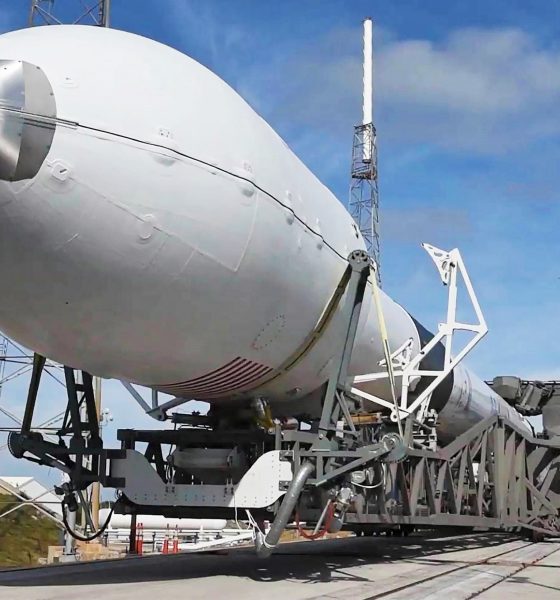

News
SpaceX on track for US Air Force Falcon 9 mission later this year
Reading between the lines, the US Air Force has effectively confirmed that GPS III Space Vehicle 03 (SV03) – the third GPS III satellite built by Lockheed Martin – is ready for launch aboard a SpaceX Falcon 9 rocket, scheduled no earlier than December 2019.
In December 2018, SpaceX successfully launched the first GPS III spacecraft aboard an expendable Falcon 9 Block 5 rocket, kicking off a launch campaign – shared between SpaceX and ULA – that will likely last until 2023 or 2024. Thus far, ULA has won a single GPS III launch contract, scheduled for July 2019, while SpaceX has won three (with options for two more). Thanks to competition forcefully reintroduced by a 2014 SpaceX lawsuit, the USAF – and thus US taxpayers – are likely saving a minimum of $50M per GPS III launch.
In late 2018, SpaceX’s closer followers were surprised to discover that brand new Falcon 9 Block 5 booster B1054 – the first to be officially certified for a critical operational military launch – was to be expended, making no attempt to land. This was confusing for several reasons.
“If Falcon 9 [was to be] expended solely because of mission performance requirements, despite the oddly low payload mass (~3800 kg) and comparatively low-energy orbit (~20,000 km), the only possible explanation for no attempted recovery would be the need for Falcon 9’s upper stage to circularize the orbit after a long coast. However, the mission parameters the USAF shopped around for would have placed the GPS III satellite into an elliptical orbit of 1000 km by 20,181 km, an orbit that would almost without a doubt leave Falcon 9 with enough propellant for a drone ship recovery.”
— Teslarati.com, December 2018
As it turns out, there was, in fact, nothing unique about the elliptical, medium-energy orbit GPS III SV01 was placed in. According to external analysis of the Falcon 9 upper stage’s final deorbit activities, SpaceX had “plenty of extra performance available”, objectively indicating that that excess performance was intentionally removed from booster B1054 at the cost of its ability to land. The (unconfirmed) reason for this is quite simple: the US Air Force chose extreme – perhaps even excessive – caution to account for the minute chance that myriad failures might happen mid-launch.
To sacrifice, or not to sacrifice
According to a USAF statement made in mid-May, GPS III Space Vehicle 03 (SV03) has been officially classed as “available for launch”, jargon that means the satellite is fully assembled and has successfully completed extensive pre-launch testing. For SpaceX’s inaugural GPS III launch (SV01), a pathfinder that carried unique wait and likely took additional processing time, SpaceX and the USAF took roughly five months to go from shipping the satellite to Florida to going vertical atop Falcon 9. More likely than not, GPS III SV03 has already begun to be prepared for transport from California to Florida, meaning that SV03 is roughly 1-2 months ahead of the schedule SV01 followed ahead of its Falcon 9 launch debut.
So: the GPS III satellite is ready for launch. The next critical milestones will be the satellite’s transport to Florida and SpaceX’s completion of the mission’s USAF-grade Falcon 9. B1054’s technically unnecessary sacrifice thus raises a question for SpaceX’s next GPS III launch, currently scheduled no earlier than December 2018: will another fresh Falcon 9 Block 5 booster be sacrificed to the gods of Obsessively Cautious Margins?

The optimist in me wants to say, “Of course!” With GPS III SV01, SpaceX perfectly demonstrated Falcon 9’s performance and permitted the USAF the luxury of expending a brand new Falcon 9 booster to satisfy the customer’s desire for extremely cautious margins. The Falcon 9 upper stage’s luxuriously expensive (in terms of delta V) deorbit burns – performed after a several-hour cost in orbit – served as another definitive demonstration of the rocket’s intentionally underutilized performance. Having demonstrated a flawless launch with margins on margins, it seems reasonable that the US Air Force would permit SpaceX the freedom to recover Falcon 9 B105x after launching GPS III SV03.
On the other hand, the USAF and Department of Defense are not exactly known for their rational, evidence-based strategies of decision-making and procurement. As such, it’s safe to say that – without official info from SpaceX or the USAF – the answer to the question of whether SpaceX will need to continue expending valuable boosters for GPS launches is entirely up in the air – call it a 50-50 split.

In the meantime, GPS III SV03’s Falcon 9 booster is likely several months away from shipping off to SpaceX’s McGregor, Texas facilities for static fire testing. Up next for SpaceX is a critical Falcon Heavy launch that could secure the rocket’s certification for US military launches, become the first USAF mission to utilize flight-proven SpaceX boosters, and pave the way for the USAF to develop a dedicated certification process for launching on commercially-developed reusable rockets.
Check out Teslarati’s Marketplace! We offer Tesla accessories, including for the Tesla Cybertruck and Tesla Model 3.

News
Tesla enters interesting situation with Full Self-Driving in California

Tesla has entered an interesting situation with its Full Self-Driving suite in California, as the State’s Department of Motor Vehicles had adopted an order for a suspension of the company’s sales license, but it immediately put it on hold.
The company has been granted a reprieve as the DMV is giving Tesla an opportunity to “remedy the situation.” After the suspension was recommended for 30 days as a penalty, the DMV said it would give Tesla 90 days to allow the company to come into compliance.
The DMV is accusing Tesla of misleading consumers by using words like Autopilot and Full Self-Driving on its advanced driver assistance (ADAS) features.
The State’s DMV Director, Steve Gordon, said that he hoped “Tesla will find a way to get these misleading statements corrected.” However, Tesla responded to the story on Tuesday, stating that this was a “consumer protection” order for the company using the term Autopilot.
It said “not one single customer came forward to say there’s a problem.” It added that “sales in California will continue uninterrupted.”
This was a “consumer protection” order about the use of the term “Autopilot” in a case where not one single customer came forward to say there’s a problem.
Sales in California will continue uninterrupted.
— Tesla North America (@tesla_na) December 17, 2025
Tesla has used the terms Autopilot and Full Self-Driving for years, but has added the term “(Supervised)” to the end of the FSD suite, hoping to remedy some of the potential issues that regulators in various areas might have with the labeling of the program.
It might not be too long before Tesla stops catching flak for using the Full Self-Driving name to describe its platform.
Tesla Robotaxi goes driverless as Musk confirms Safety Monitor removal testing
The Robotaxi suite has continued to improve, and this week, vehicles were spotted in Austin without any occupants. CEO Elon Musk would later confirm that Tesla had started testing driverless rides in Austin, hoping to launch rides without any supervision by the end of the year.
Investor's Corner
Tesla stock closes at all-time high on heels of Robotaxi progress

Tesla stock (NASDAQ: TSLA) closed at an all-time high on Tuesday, jumping over 3 percent during the day and finishing at $489.88.
The price beats the previous record close, which was $479.86.
Shares have had a crazy year, dipping more than 40 percent from the start of the year. The stock then started to recover once again around late April, when its price started to climb back up from the low $200 level.
This week, Tesla started to climb toward its highest levels ever, as it was revealed on Sunday that the company was testing driverless Robotaxis in Austin. The spike in value pushed the company’s valuation to $1.63 trillion.
Tesla Robotaxi goes driverless as Musk confirms Safety Monitor removal testing
It is the seventh-most valuable company on the market currently, trailing Nvidia, Apple, Alphabet (Google), Microsoft, Amazon, and Meta.
Shares closed up $14.57 today, up over 3 percent.
The stock has gone through a lot this year, as previously mentioned. Shares tumbled in Q1 due to CEO Elon Musk’s involvement with the Department of Government Efficiency (DOGE), which pulled his attention away from his companies and left a major overhang on their valuations.
However, things started to rebound halfway through the year, and as the government started to phase out the $7,500 tax credit, demand spiked as consumers tried to take advantage of it.
Q3 deliveries were the highest in company history, and Tesla responded to the loss of the tax credit with the launch of the Model 3 and Model Y Standard.
Additionally, analysts have announced high expectations this week for the company on Wall Street as Robotaxi continues to be the focus. With autonomy within Tesla’s sights, things are moving in the direction of Robotaxi being a major catalyst for growth on the Street in the coming year.
Elon Musk
Tesla needs to come through on this one Robotaxi metric, analyst says
“We think the key focus from here will be how fast Tesla can scale driverless operations (including if Tesla’s approach to software/hardware allows it to scale significantly faster than competitors, as the company has argued), and on profitability.”

Tesla needs to come through on this one Robotaxi metric, Mark Delaney of Goldman Sachs says.
Tesla is in the process of rolling out its Robotaxi platform to areas outside of Austin and the California Bay Area. It has plans to launch in five additional cities, including Houston, Dallas, Miami, Las Vegas, and Phoenix.
However, the company’s expansion is not what the focus needs to be, according to Delaney. It’s the speed of deployment.
The analyst said:
“We think the key focus from here will be how fast Tesla can scale driverless operations (including if Tesla’s approach to software/hardware allows it to scale significantly faster than competitors, as the company has argued), and on profitability.”
Profitability will come as the Robotaxi fleet expands. Making that money will be dependent on when Tesla can initiate rides in more areas, giving more customers access to the program.
There are some additional things that the company needs to make happen ahead of the major Robotaxi expansion, one of those things is launching driverless rides in Austin, the first city in which it launched the program.
This week, Tesla started testing driverless Robotaxi rides in Austin, as two different Model Y units were spotted with no occupants, a huge step in the company’s plans for the ride-sharing platform.
Tesla Robotaxi goes driverless as Musk confirms Safety Monitor removal testing
CEO Elon Musk has been hoping to remove Safety Monitors from Robotaxis in Austin for several months, first mentioning the plan to have them out by the end of 2025 in September. He confirmed on Sunday that Tesla had officially removed vehicle occupants and started testing truly unsupervised rides.
Although Safety Monitors in Austin have been sitting in the passenger’s seat, they have still had the ability to override things in case of an emergency. After all, the ultimate goal was safety and avoiding any accidents or injuries.
Goldman Sachs reiterated its ‘Neutral’ rating and its $400 price target. Delaney said, “Tesla is making progress with its autonomous technology,” and recent developments make it evident that this is true.











